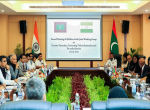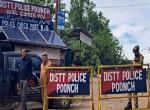Introduction
Bharat has been facing terrorism ever since it became independent in 1947. Post-invasion of Kashmir by Pakistan-sponsored militants in October 1948 and followed by the defeat in the Indo-Pak war in 1965, Pakistan realised that it was impossible to defeat Bharat in conventional warfare. Therefore, Pakistan resorted to proxy war in the form of sponsoring cross-border terrorism in the Kashmir Valley. Besides, the Pakistani intelligence agency, Inter-Service Intelligence (ISI), is infamous for encouraging separatist tendencies and fuelling terrorism in Kashmir. Given such vulnerabilities, it is pertinent to understand the process of radicalisation by which an individual or a group(s) are transformed into terrorists.
Radicalisation can be understood as a process whereby, under certain enabling circumstances, such as social, political, economic, or psychological, an individual resorts to extremist and violent activities, eventually leading to terrorism. According to the United States (US)Department of Homeland Security (DHS), radicalisation is “the process of adopting an extremist belief system, including the willingness to use, support, or facilitate violence, as a method to effect social change.”[1] Various scholars have defined the radicalisation process differently. For instance, McCauley and Moskalenko define radicalisation as the “development of beliefs, feelings and actions in support of any group or cause in a conflict.”[2] The international community is facing challenges in defining terrorism and radicalisation.
However, there are specific potential drivers which trigger radicalisation. According to Jerrold Post, in a society where a particular section of the population is being persecuted based on religion or ethnicity and faces deprivation, the need to own control over their lives among such people is intensified. There is a constant need to belong and to have an identity.[3] These individuals or the group is vulnerable to radicalisation by the terrorist organisation. Moghaddam’s ‘Staircase model’ provides six stages before an individual transforms into a terrorist. According to the ‘Staircase model’, individuals experience injustice and unfair treatment at the first stage. The second stage is a search for options to address the grievances through a constitutional framework. The individual then reaches the third stage, where aggression is displaced through an ‘us v/s them’ mentality. Those who are ready to vent out aggression through physical means enter the fourth stage, where a terrorist organisation is seen as a parallel world, and the struggle to achieve an ideal is justified. In the fifth stage, an individual becomes a recruit with solidification of categorical thinking. Ultimately, by the time an individual reaches the sixth and final stage, they have transformed into a terrorist, resorting to violence against civilians.[4]
On the grounds of psychology, there have been studies to analyse the mindset of radicalised youth. However, contrary to certain studies which believe that terrorists are psychopaths, Martha Crenshaw opines that terrorist acts are a result of ‘strategic and rational choices.’[5] In Bharat, radicalisation has been a significant concern in certain states like Kerala and Kashmir Valley. The youth feel disillusioned with the State due to various socio-political and economic factors and take up arms for their cause.
Case Study: Islamic Extremism in Kashmir
From Sufism to Salafism
Kashmir has traditionally been a liberal society, comprising various faiths and belief systems. ‘Kashmiriyat’ or Kashmir’s basic identity has been one of a composite nature. Hinduism and Buddhism flourished simultaneously in Kashmir, followed by the introduction of Islam. Islam was accepted by the people “as a culmination of proud cultural heritage.”[6] Thus, the culture depicted a sense of pluralism.
However, this pluralism gradually led to extremist tendencies, primarily due to foreign intervention in the valley. The syncretic Sufism is fading as the aggressive interpretation of Salafism is taking over Kashmir. Salafism is based on the emulation of Salaf, the predecessor or the ancestor. Therefore, Salafis are allegedly considered as a more authentic or purer sect within Sunni Islam. Salafis term their positions as that of “true believers.” They distinguish themselves from other interpretations of Islam by claiming the purity of Salaf and denouncing excessive spiritualism associated with Sufism. Salafis are considered mainly as ‘quietists’ who choose to stay away from politics. Their primary focus lies on purifying Islam to bring it closer to the purity of the Salaf. Besides, they spread this form of Islam through education and missionary activities.[7]
In Kashmir Valley, the Salafi mosques are outnumbering old Sufi mosques. The mushrooming of Salafi mosques has led to more people visiting them, especially the young generation. The gullible Muslim youth is being fed an ultra-conservative and fundamentalist view of the world. By such distorted interpretations of world events, they are compelled to believe that Islam is in “danger”. By instilling such beliefs among the youth, terrorist organisations create a fertile ground for recruitment.[8] Radicalisation through theological means is one of the severe concerns. This is because mosques are meant for public gatherings, and terrorist propaganda can be easily spread by way of sermons or even by extending personal contact with people. Through communication, the organisations identify potential recruits based on their views, opinions, and inclination to violence to address grievances. Those vulnerable to the propaganda are then dragged into it by enhancing communication and providing access to the group and their ideology. This process is accelerated in case the people are socially backward, economically deprived or politically unaware. When unable to seek redressal to the issues through constitutional means, the population looks towards violence to fulfill their needs and demands. Such circumstances are exploited by the extremist elements for their vested interests. They promise better living standards and rewards in the afterlife for participation in jihad.
Kashmir has historically witnessed instability due to conventional and proxy wars. The rise of extremist tendencies in the former State led to worsening security. This, in turn, led to heavy deployment of troops. Besides, Articles 370 and 35A of Bharat’s Constitution, repealed on 05 August 2019, had hindered the complete integration of the former State into the rest of Bharat. The incomplete integration, coupled with a slower pace of development and subsequent frustration due to economic and political conditions, provided a fertile ground for the growth of violent and extremist approaches in the valley. In such circumstances, the radicalisation carried out by terrorist outfits proved to be more effective.
Terrorist/Extremist Organisations in Kashmir
Radicalisation in Kashmir is a product of concerted efforts towards this end by various terrorist networks supported by Pakistan. Most of the terror groups advocate Pakistan’s position on Kashmir and want the former State to integrate with Pakistan. However, the approaches followed by these groups vary widely. Certain groups walk the path of political Islam, while others prefer to be called a socio-religious movement. Their methods to lure people into their fold are different.
Jamaat-e-Islami (JeI)
Realising their lack of strength compared to Bharat’s military power, the militants shifted their strategy to the manipulation of the mindset of Kashmiris. Jamaat-e-Islami (JeI) has been at the forefront of this task. JeI propagates political Islam, meaning the Sharia law should be applied to all activities including in political matters. They follow the Hanafi school and disregard non-Muslims and other sects within Islam. Politically, they support Pakistan’s claims over Kashmir.[9]
The group was officially formed in 1952 by Syed Abul A'la Maududi Chishti. It started mobilising people to follow Islamic principles. From their successful campaigns, it is evident that the group had been well-equipped for the purpose. Education was the primary tool used by JeI to spread their propaganda. Kashmir has been under political turmoil since independence. Owing to this, the former State lacked quality state-run educational institutions. Filling in the gap, JeI started their schools, which taught subjects like English and Mathematics but also focussed on Urdu, Arabic and Islamic studies. The demand for JeI schools increased, and the network spread to various parts of Kashmir.[10] In 2016,321 Jamaat schools had 80,000 students and 4000 teachers.[11] Besides, they had their libraries and madrasas[12] The literature circulated by JeI through these media is a significant source of radicalisation. Extensive literature on Islam and its fundamentalist interpretations is readily available in bookshops and is widely read in schools and colleges.[13] The easy access to literature coupled with teachings in schools and the working of madrasas, have contributed significantly to radicalising young minds and turning them towards jihad. JeI’s penetration in social, political and intellectual circles is profound, increasing its influence.
JeI believed in political Islam and therefore formed their political party. People were introduced to their political ideology in their religious congregations— Ijtemas. The Jamaat contested elections and secured seats in the State Assembly. They had considerable influence in areas like Sopore and Kulgam. However, the Jamaat was banned by the Government of Bharat in 1975, 1990, and 2019. However, the organisation continued its engagement with the people through welfare and development activities togain popularity among Kashmiris.[14] The JeI has become deeply entrenched in Kashmiri politics and society. It is now upon the State to uproot the organisation from Kashmir. A better social and political integration of people would do much to serve the purpose. Besides, there is a need to have better state-run educational institutions and adequate employment opportunities to engage the youth constructively. Since radicalisation has taken place gradually over decades through public participation, counter-radicalisation should follow a similar path of involving local people and intellectuals. The mistrust towards the government has to be countered efficiently by taking up welfare projects and other confidence-building measures. Terrorist propaganda can be resisted only when people trust their rulers.
Hizb-ul-Mujahideen (HM)
Several terror outfits emerged as offshoots of JeI, taking advantage of their established network. Hizb-ul-Mujahideen (HM) is one such organisation. It came up in 1989 during great political and religious turmoil in Kashmir. HM supports the merger of Kashmir with Pakistan and is a state-sponsored group backed by the Pakistan government and ISI. Besides, JeI also significantly contributes to the activities of the group. The favourable apparatus by JeI in the form of educational institutions and political parties is being used by HM to attract youth towards its cause of the secession of Kashmir from Bharat. Within a decade of its formation, in the late 1990s, HM accounted for 65 per centof violence in Kashmir valley. Their major targets were those propagating pro-Bharat sentiments, minorities and security personnel.[15]
Jaish-e-Mohammed (JeM)
Jaish-e-Mohammed (JeM) was formed in 2000 under the leadership of Maulana Masood Azhar. It is a Pakistan-based militant organisation responsible for terror attacks in Bharat, including the one on the Bharatiya Parliament in 2001. JeM is said to have links with other terror organisations in Pakistan, particularly Lashkar-e-Taiba (LeT). Like other groups sponsored by Pakistan, JeM also aims to propagate anti-Bharat agenda and merge Kashmir with Pakistan.[16] It was JeM who brought the phenomenon of suicide bombings in Kashmir in its first major strike in 2000.[17]
The JeM has put conscious efforts into gaining popularity and attracting people towards their cause. It is said to have a special “department of motivation”, initially headed by Azhar. Besides, they also had publications to propagate their ideology.[18] This provides evidence of the continued legacy of JeM, which also focussed on literature as a medium to radicalise youth. This also entails that people joining the organisation are literate and make a choice after going through the literature provided by the group.
Radicalisation in Kashmir also pertains to unstable socio-political conditions in the former State and interventions by foreign elements. Dedicated law and security agencies have a major role in tackling these foreign elements. Nevertheless, the solution is in strengthening social and political integration.
Case Study: Islamic Extremism in Kerala
Kerala is often termed as ‘God’s own country’ due to nature’s bounty and vibrant culture that the State portrays. Therefore, Kerala becoming a hotspot for radicalisation is an unlikely guess. However, the severe consequences of the radicalisation campaigns in the State came to light when 21 residents of Kerala travelled to join the Islamic State (IS) in Afghanistan and Syria. The motivation to migrate is from the religious directive that a true Muslim is the one who migrates to “Dar-ul-Islam”, meaning the “house of peace”, from “Dar-ul-Harb”, which is the “house of war”. Besides, religiosity is also witnessed through the inclusion of skullcaps and burqas in attire and the choice to keep long beards among men.[19]
The roots of radicalisation come from Salafism. The IS sympathisers ask their followers to follow the textual version of Islam. They cite the Quran and hadith to instil their beliefs among people. The traditional Sunni population in the State opposes this form of Islam. However, Salafis have gained ground in the State, largely due to large-scale “Petro-Dollar” funding. This has led to a surge in followers of Wahhabi-Salafism, the ultra-orthodox form of Islam. Wahabi dominance can also be gauged through their control over 40 mosques in the State.[20]
Terrorist/Extremist Organisations in Kerala
Most of the organisations involved in the process of radicalisation in Kerala have penetrated through West Asian connections. These organisations have then branched out to create different sub-groups focusing on finances, indoctrination, etcetera by posing as charitable trusts or other non-governmental organisations (NGOs).
The Islamic State (IS)
Bharat has one of the largest Muslim populationsin the world. Despite this, Bharat has lower counts of foreign terrorist fighters (FTFs) joining transnational terrorist organisations such as IS and al-Qa’ida. However, some people from the Southern part of Bharat have travelled to the IS-controlled areas in Iraq, Syria, and Afghanistan. This shows the presence and gradual rise of radicalisation in the State.
The IS has used conventional and non-conventional (asymmetric) means of warfare. The IS has a unique understanding of the world system. According to them, there are no nation-states or system of states, but rather a “perpetually expanding caliphate”. The areas directly controlled by the IS are termed ‘Core’, while the rest of the world is called ‘Periphery’.[21] This thought process widened the scope to disregard state authority and create a proto-state, or the Caliphate as it is called.
The IS messaging uses the constructs relating to identity, crisis and solution. These engagements are for their audiences to know that they are the “real” protectors of the Sunni version of Islam. Moreover, their main propaganda is championing their leadership as the sole solution to the “enemy” induced crisis. The “enemy” here is those who do not align with the IS ideology. Such propagation compels its audience to believe that Islam, followed by the IS, is the purest and the most divine form and that all those who do not adhere to this version of Islam are not worthy of life and should be destroyed.[22] Online platforms are widely used to spread such propaganda, which provides them access to a larger audience. IS has several magazines, including in English, which are regularly released.
Moreover, they also reach out to the audience through messaging applications such as Telegram and WhatsApp. In Kerala, in particular, IS has launched blogs in Malayalam. One such blog, Muhajir, had posted extensively on life in the Caliphate. However, the posts were taken down by authorities. Besides, other blogs call for Bharatiya Muslims to join their duty in the Caliphate and reject ideas like democracy and secularism, as these are anti-Islam.[23]
Popular Front of India (PFI)
Popular Front of Bharat (PFI) was formed in 2006 as the successor of the National Democratic Front (NDF). NDF was created in the aftermath of the demolition of Babri masjid in December 1992. PFI claims to be a non-profit organisation engaged in social work. However, it is a fundamentalist organisation with a firm adherence to political Islam. Though based in Kerala, it spread to other states like Karnataka, Tamil Nadu, Andhra Pradesh and Manipur. By 2009, some social organisations from other states merged with PFI, but it was most active in Kerala. All India Imam Council (AIIC) and Satya Sarini, two units of PFI, actively engage in conversions.[24]
The National Investigation Agency (NIA) released a 19-page dossier on PFI. According to the document, PFI has a well-established machinery to engage in terrorist activities. The organisation has experts in making Improvised Explosive Devices (IEDs) and crude bombs. Besides, there are trainers to train recruits in martial arts and indoctrinate them with the group’s ideology. Sharp weapons such as swords, bombs and wooden targets have been seized from PFI camps in Kannur during the raids carried out by the NIA. The dossier also traced the funds coming from Gulf countries. These funds are collected by separate organisations that the PFI floats as charitable trusts or NGOs. There are apprehensions that huge funds have been received through the India Fraternity Forum (IFF). Besides finances from the Gulf, they also collect membership fees and special collections during Ramadan. Muslims in the business community also contribute significantly to the organisation. According to the NIA, PFI is a “threat to national security” and is engaged in forced conversions in the State.[25]
Kerala has been a vital state for Bharat, given its high literacy rates and high amounts of remittances that the State gains through its West Asian contacts. However, the same connections are now subtly pushing the State towards becoming a hotbed for radicalisation and terrorism. There is a need to keep a tight check on finances from the Gulf towards non-profit organisations in the State. Besides, people need to be rooted deeply in their belief systems at the ground level, and their trust in public institutions must be strengthened.
Conclusion
Radicalisation in Kashmir and Kerala has taken different shapes; one in Kashmir has been in person through meetings and sermons, whereas in Kerala, the groups have adopted the hybrid mode, mainly virtual. However, both approaches have proved to be effective for the terrorists as people have adhered to the alternative belief systems. In these circumstances, it is essential to adopt efficient counter-radicalisation techniques in these regions.
Counter-radicalisation measures should adopt a people-centric approach, as they are the soft targets for terror outfits. Political and social integration of the people shall be a vital primary step. Strengthening trust between the governments— Central and State, and the people at large has to become a priority. Radicalisation can also be prevented at the lowest levels by instilling specific values among children at the school level. Family is equally important, as it helps nourish individuals’ social roots and belief systems. Thus, a multi-pronged approach involving various stakeholders should be in action to eradicate the menace of radicalisation from Bharat.
Endnotes
[1]A. Schmid, “Radicalisation, De-Radicalisation, Counter-Radicalisation: A Conceptual Discussion and Literature Review”, International Centre for Counter-Terrorism (Research Paper, March 2013); Manea, Elham (2017). Defining the phenomenon of jihadist radicalisation: drivers and catalysts local & global. In: EPC. The challenge of jihadist radicalisation in Europe and beyond. Brussels: European Policy Centre, 22-34.
[2]A. Pandya “Radicalisation in Bharat: An Exploration”, Vivekananda International Foundation
[3]J. Forest, “Terrorism Lectures” 2019. Nortia Press
[4] F.Moghaddam, “The Staircase to Terrorism”, 2005. American Psychologist.
[5]J. Forest, “Terrorism Lectures” 2019. Nortia Press
[6]D. Ahlawat & S. Malik. “Kashmir Imbroglio” Journal of Indo-Pacific Affairs Summer 2019. Accessed on 30 July 2023
[7]J.Wagemakers,“Salafism”. Oxford Research Encyclopedias. Published on: 05 August 2016. Accessed on: 03 July 2023
[8]M. Kishwar. “TV channel jingoism is helping separatists even as Salafist Islam takes root in Kashmir” Published in: First Post on 24 July 2015. Available at: TV channel jingoism is helping separatists even as Salafist Islam takes root in Kashmir-Bharat News , FirstpostAccessed on: 03 July 2023
[9]A. Pandya, “Radicalisation in Bharat: An Exploration”, Vivekananda International Foundation
[10]Y. Sikand, “The Emergence and Development of Jama’at-i-Islami of Jammu and Kashmir (1940s-1990)”. Modern Asian Studies, Volume 36, Issue 3, July 2002. Accessed on: 06 July 2023.
[11]U. Gul, “Playing Politics with the Jamaat in Kashmir” The Hindu Centre for Politics and Public Policy. Published on: 18 March 2019. Available at: Playing Politics with the Jamaat in Kashmir - The Hindu Centre Accessed on: 06 July 2023
[12]M. Ahmad, “The Curious Case of Jama’at-e-Islami in Jammu and Kashmir”. IDSA Comment. Published on: 14 October 2021. Accessed on: 04 July 2023. Available at: The Curious Case of Jama’at-e-Islami Jammu and Kashmir | Manohar Parrikar Institute for Defence Studies and Analyses (idsa.in)
[13]A. Pandya. “Radicalisation in Bharat: An Exploration” Vivekananda International Foundation
[14]U. Gul. “Playing Politics with the Jamaat in Kashmir” The Hindu Centre for Politics and Public Policy. Published on: 18 March 2019. Available at: Playing Politics with the Jamaat in Kashmir - The Hindu Centre Accessed on: 06 July 2023
[15]K. Santhanam, Sreedhar, Sudhir Saxena & Manish. Hizbul Mujahideen “Jihadis in Jammu and Kashmir”. Published: 2003. Published by: Sage Publications and Institute for Defence Studies and Analyses (IDSA)
[16]J. Mackenzie & S. Miglani. “Explainer: Jaish-e-Mohammad, the Pakistan-based militants, at heart of tension with Bharat” Reuters. Published on: 15 February 2019. Available at: Explainer: Jaish-e-Mohammad, the Pakistan-based militants, at heart of tension with Bharat | ReutersAccessed on: 06 July 2023
[17] “Jaish-e-Mohammed: Terror outfit once crushed in Kashmir, now in revival effort” Bharatn Express. Published on: 27 February 2019. Available at: Jaish-e-Mohammed: Terror outfit once crushed in Kashmir, now in revival effort | Explained News,TheBharatn Express Accessed on: 06 July 2023
[18]Ibid
[19]A. Pandya. “Radicalisation in Bharat: An Exploration” Pg 57
[20]Ibid
[21]S. Johny, “The ISIS Caliphate: From Syria to the Doorsteps of Bharat” Bloomsbury Publishing, April 18, 2013.
[22]H. Ingram, “Islamic State’s English-language magazines, 2014-2017: Trends & implications for CT-CVE strategic communications” International Centre for Counter-Terrorism, 2018.
[23]S. Johny, “The ISIS Caliphate: From Syria to the Doorsteps of Bharat” Bloomsbury Publishing, April 18, 2013.
[24]A. Pandya, “Radicalisation in Bharat: An Exploration.”
[25]K. Sandhu. “Kerala-based Islamist Organisation PFI’s Gulf Link Exposed; NIA claims it collected funds from expatriates.” Published in: Bharat Today Published on: 27 September 2023. Accessed on: 14 July 2023. Available at: Kerala-based Islamist organisation PFI's Gulf link exposed; NIA claims it collected funds from expatriates - Bharat Today
(The paper is the author’s individual scholastic articulation. The author certifies that the article/paper is original in content, unpublished and it has not been submitted for publication/web upload elsewhere, and that the facts and figures quoted are duly referenced, as needed, and are believed to be correct). (The paper does not necessarily represent the organisational stance... More >>
Image Source: https://www.agilient.com.au/wp-content/uploads/2017/11/radicalisation.png











Post new comment